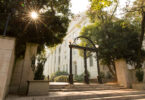Art is meant to inspire, especially when it comes to propaganda.
“In April 1917, the United States declared war on Germany. In the buildup, American artists and illustrators, and some filmmakers, sold the war to a public that initially remained reluctant to take up arms,” said David Lubin, the Charlotte C. Weber Professor of Art at Wake Forest University.
Lubin’s talk, “Oh, Say Can You See: American Art, Propaganda and the First World War,” was held Oct. 18 at the Georgia Museum of Art as part of the fall Signature Lecture series. The event was co-sponsored by the Georgia Museum of Art and the College of Environment and Design.
Lubin believes it’s important to “squeeze paintings to understand what they meant to the people of the time politically, socially, economically.”
His lecture focused on Childe Hassam’s series of flag paintings, particularly Hassam’s 1917 painting “Early Morning on the Avenue in May,” which shows pedestrians, mostly women, on Fifth Avenue in New York City walking beneath Allied flags hanging from buildings.
“The red, white and blue color scheme of Hassam’s painting is no accident,” Lubin said. “Attesting to the fervor at that moment in history when the United States shrugged off its age-old policy of political isolation and jumped jubilantly onto the world stage, the painting uses flags, femininity, commercial culture and religious worship to remind viewers of the democratic values that they supposedly were going to war to defend.
“American art during the First World War was never monolithic, with artists, propagandists and commercial illustrators all riding the same express train in support of the nation’s war efforts. Far from it. During this period of political turbulence, artists moved in dramatically different directions from one another,” Lubin also said. “World War I was the first time in American history that artists and other makers of compelling visual imagery exerted formidable influence in the way their fellow Americans engaged with and thought about war.”




